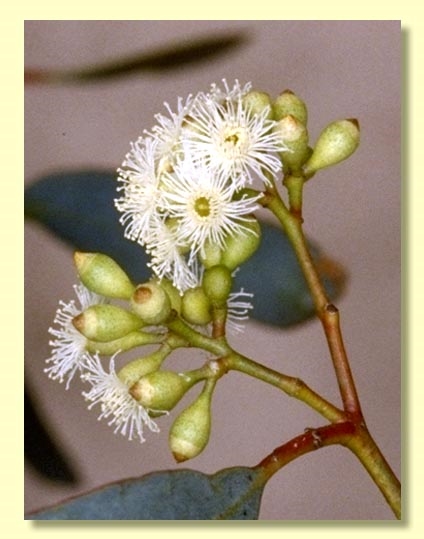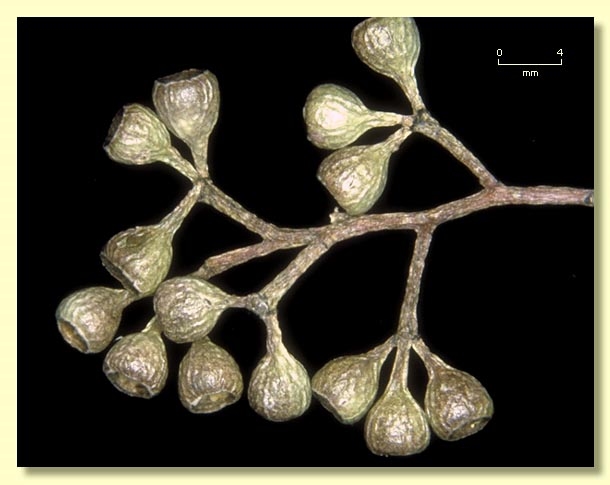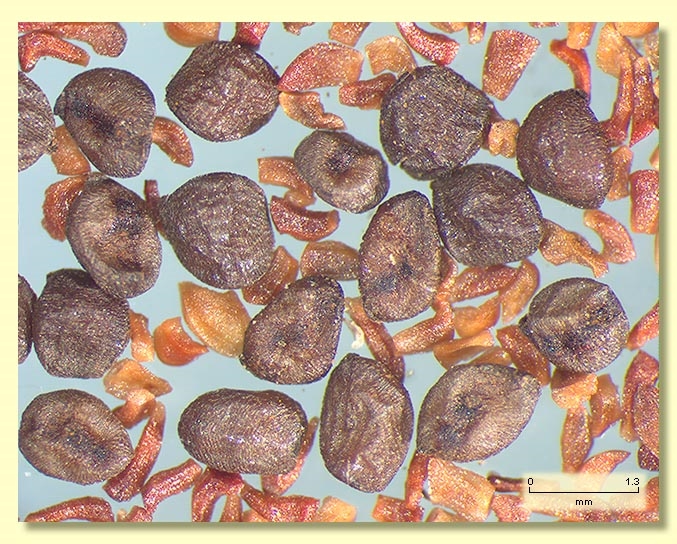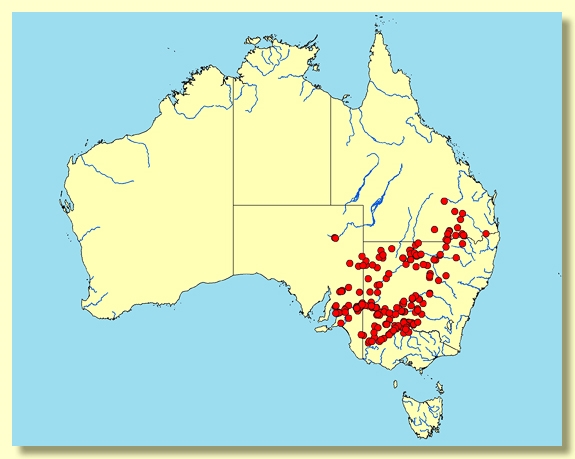Euclid - Online edition
Eucalyptus largiflorens
Eucalyptus | Symphyomyrtus | Adnataria | Apicales | Buxeales | Amissae
T: Murray R. above Moorundie, S.A., 1 Feb. 1851, F.Mueller s.n.; lecto: MEL 10392, fide J.H.Willis, Muelleria 1: 166–167 (1967); isolecto: K.
[Eucalyptus bicolor A.Cunn. ex T.Mitch., J. Exped. Trop. Australia 390 (1848). T: subtropical Australia, 20 Nov. 1846, T.L.Mitchell 439; holo: K; iso: CGE, PERTH; fide Chippendale, Fl. Austral 19: 384 (1988). (The description of E. bicolor was not sufficent to validate publication).]
Tree to 20 m tall. Forming a lignotuber.
Bark rough to small branches, box-type often tessellated, dark grey.
Juvenile stem rounded in cross-section; juvenile leaves shortly petiolate, opposite until node 5 to 8 then alternate, narrowly lanceolate to linear, 4–15.5 cm long, 0.4–1.8 cm wide, dull, blue-grey to grey-green.
Adult leaves alternate, petiole 0.5–2 cm long; blade lanceolate, 6–18 cm long, 0.8–2 cm wide, base tapering to petiole, concolorous, glossy or dull, green to grey-green, side-veins at an acute or wider angle to midrib, densely reticulate, intramarginal vein parallel to and well removed from margin, oil glands numerous and small, mostly intersectional, or sometimes obscure.
Inflorescence terminal compound, or with some axillary compound also, peduncles 0.1–1.1 cm long; buds 7, 9 or 11 per umbel, pedicels 0.1–0.5 cm long. Mature buds obovoid to ovoid, 0.3–0.5 cm long, 0.2–0.3 cm wide, green to yellow, scar usually present (outer operculum shed early or occasionally imperfectly shed), operculum conical to rounded, or shortly beaked, stamens regularly inflexed or irregularly flexed, all fertile, anthers adnate, globoid, dehiscing by lateral or subterminal pores, style long, stigma blunt, locules 3 or 4, the placentae each with 4 vertical ovule rows. Flowers white.
Fruit pedicellate (pedicels 0.1–0.5 cm long), usually hemispherical to cupular or barrel-shaped, 0.3–0.5 cm long, 0.3–0.5 cm wide, disc descending, valves 3 or 4, near rim level or enclosed.
Seeds black, grey or brown, 1–1.5 mm long, ovoid or flattened-ovoid, dorsal surface shallowly reticulate, hilum ventral.
Cultivated seedlings (measured at ca node 10): cotyledons reniform to oblong; stems rounded in cross-section; leaves always at least shortly petiolate, opposite for about 5 to 10 nodes, linear to narrowly lanceolate, 7–15.5 cm long, 0.5–1.5 cm wide, dull, grey-green.
Flowering has been recorded in January, March, May, June, July, August, September, October, November and December.
A medium-sized box tree widespread on flood plains of the Murray-Darling River systems from south-eastern Queensland, New South Wales and Victoria and South Australia, also occurring north of Adelaide and to a lesser extent in the Lake Frome and Lake Eyre watersheds in north-eastern South Australia. It grows on infrequently inundated floodplains on grey to grey-brown clay soils and tolerates drier sites than the other river gum, Eucalyptus camaldulensis. Often of poor form with the wide-spreading canopy reaching to the ground, Eucalyptus largiflorens is distinguished by the rough furrowed box-type bark to the small branches, linear, blue-grey juvenile leaves, the narrowly lanceolate adult leaves, the small buds arranged in terminal or axillary compound inflorescences, and small cupular fruit. The outer operculum of the buds may be semi-persistent.
Within its natural range and habitat it is a distinctive and easily identified species. In comparison river red gum, E. camaldulensis, is smooth-barked throughout, has buds in small axillary clusters and fruit with conspicuously exserted valves. The only other box-barked species within its area of occurence likely to be confused is E. microcarpa, which has slightly larger more barrel-shaped fruit, smooth bark on the larger branches and prefers slightly lighter soils (though still somewha clayey) away from streams. In central and northern Queensland is another closely related species, E. persistens. Morphologically there is not a lot separating E. persistens from E. largiflorens. Both have box bark to the small branches, both have narrow juvenile leaves, both have similar leaf venation, both have buds where the outer operculum can shed before anthesis or remain intact and both opercula shed together at anthesis. Apart from both occupying quite different habitats in different geographic regions, there is not a lot more we can offer to help separate these two species.
A related, similar-looking small tree, E. sp. Cockburn, occurs as a single stand between Cockburn and Lake Frome, South Australia. It is distinguished by the glossy green leaves and flowers which are variable in having all stamens fertile on some trees and on other trees flowers with outer staminodes and inner stamens fertile.
Eucalyptus largiflorens belongs in Eucalyptus subgenus Symphyomyrtus section Adnataria (the boxes) because the buds have two opercula, ovules are in four rows, seeds are flattened-ovoid, cotyledons are reniform, and anthers are rigid on the staminal filaments. Within section Adnataria, E. largiflorens is part of a subgroup, series Buxeales, further distinguished by terminal inflorescences, buds that lose the outer operculum early in development, have irregularly flexed stamens all fertile and dull leaves.
Seedling regeneration of both E. largiflorens and E. camaldulensis is common after flooding; seedlings of the former have narrower and shorter leaves.













